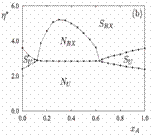Structure and Nanomechanics of Linear Dendronised Polymers: A Molecular Simulation Study, D. K. Christopoulos, D. J. Photinos, L. M. Stimson, A. F. Terzis and A. G. Vanakaras, J. Mater. Chem. 13, 2756-2764 (2003).
Abstract: We use Monte Carlo algorithms to simulate, on the atomistic scale, the structure and rigidity of model linear dendronised polymers (LDPs) consisting of a poly(para-phenylene) backbone with laterally substituted Frechet type dendritic units. A coarse-grained representation of united atoms interacting via steric repulsions is employed for the study of the equilibrium structure of single LDPs as a function of dendron generation, g. Backbone conformation averages and dendron mass distributions are calculated for g = 0 to 5 and are used to elucidate the mechanism of stiffening of the LDP with increasing g. Congestion-induced stiffening, reflecting on the response of the backbone to linear extension as well as to bend and torsion deformations, is clearly detected for g = 4 and is dramatically intensified at g = 5 where, in addition, strongly bent and twisted structures develop along the backbone contour and reduce appreciably the equilibrium elongation of the LDP.
A. G. Vanakaras and D. J. Photinos, Mol. Cryst. Liq. Cryst., 315, 213 (2003).
 Abstract: Various possibilities of polar self-organisation in low molar mass nematic, smectic and columnar liquid crystals are discussed with particular focus on the underlying molecular symmetries and interactions. Distinction is made between vector and pseudovector polarities, their quantification in terms of molecular order parameters and their relation to spontaneous electric polarisation and to molecular chirality. The understanding of the molecular mechanisms that give rise to polar ordering in existing lamellar and columnar phases may be useful for the design of new polar variants of common a-polar liquid crystals.
Abstract: Various possibilities of polar self-organisation in low molar mass nematic, smectic and columnar liquid crystals are discussed with particular focus on the underlying molecular symmetries and interactions. Distinction is made between vector and pseudovector polarities, their quantification in terms of molecular order parameters and their relation to spontaneous electric polarisation and to molecular chirality. The understanding of the molecular mechanisms that give rise to polar ordering in existing lamellar and columnar phases may be useful for the design of new polar variants of common a-polar liquid crystals.
A. G. Vanakaras, M. A. Bates and D. J. Photinos, Phys. Chem. Chem. Phys. 5(17), 3700 (2003).
 Abstract: Variational cluster calculations and Monte Carlo simulations are applied to hard-body board-like models of biaxial molecules forming liquid crystalline phases. The molecular long axes are assumed for simplicity to be fully oriented. Depending on the extent of transverse anisometry in the molecular shape, these systems can exhibit biaxial nematic phases as well as uniaxial and biaxial orthogonal smectic phases. It is shown that the region of thermodynamic stability for the biaxial nematic phase is considerably broadened in binary mixtures of molecules with the same cross section but differing in their long dimension.
Abstract: Variational cluster calculations and Monte Carlo simulations are applied to hard-body board-like models of biaxial molecules forming liquid crystalline phases. The molecular long axes are assumed for simplicity to be fully oriented. Depending on the extent of transverse anisometry in the molecular shape, these systems can exhibit biaxial nematic phases as well as uniaxial and biaxial orthogonal smectic phases. It is shown that the region of thermodynamic stability for the biaxial nematic phase is considerably broadened in binary mixtures of molecules with the same cross section but differing in their long dimension.
A. Galindo, A. J. Haslam, S. Varga, G. Jackson, A. G. Vanakaras, D. J. Photinos and D. A. Dunmur, J. Chem. Phys. 119(10), 5216 (2003).
 Abstract: The phase behavior of a binary mixture of rodlike and disclike hard molecules is studied using Monte Carlo NVT computer simulation. The rods are modeled as hard spherocylinders of aspect ratio L-HSC/D-HSC=5, and the discs as hard cut spheres of aspect ratio L-CS/D-CS=0.12. The diameter ratio D-CS/D-HSC=3.62 is chosen such that the molecular volumes of the two particles are equal. The starting configuration in the simulations is a mixed isotropic state. The phase diagram is mapped by changing the overall density of the system. At low densities stabilization of the isotropic phase relative to the ordered states is seen on mixing, and at high densities nematic-columnar and smectic A-columnar phase coexistence is observed. Biaxiality in the nematic phase is not seen. The phase diagram of the mixture is also calculated using the second virial theory of Onsager for nematic ordering, together with the scaling of Parsons and Lee to take into account the higher virial coefficients. The disc-disc and rod-disc excluded volumes are evaluated numerically using the exact overlap expressions, and the lower-order end-effects are incorporated. The exact rod-rod excluded volume is known analytically. In the case of the theoretical calculations, which are limited to translationally disordered phases, coexistence between two uniaxial nematic phases is predicted, as well as the stabilization of the disc-rich isotropic phases. As found in the simulation, biaxial nematic phases are not predicted to be stable. The phase equilibria of an experimental system is also reported which exhibits a behavior close to the system studied by computer simulation. As in the model mixtures, this system exhibits a marked destabilization of the ordered phases on mixing, while nematic-columnar demixing is observed at lower temperatures (the higher-density states).
Abstract: The phase behavior of a binary mixture of rodlike and disclike hard molecules is studied using Monte Carlo NVT computer simulation. The rods are modeled as hard spherocylinders of aspect ratio L-HSC/D-HSC=5, and the discs as hard cut spheres of aspect ratio L-CS/D-CS=0.12. The diameter ratio D-CS/D-HSC=3.62 is chosen such that the molecular volumes of the two particles are equal. The starting configuration in the simulations is a mixed isotropic state. The phase diagram is mapped by changing the overall density of the system. At low densities stabilization of the isotropic phase relative to the ordered states is seen on mixing, and at high densities nematic-columnar and smectic A-columnar phase coexistence is observed. Biaxiality in the nematic phase is not seen. The phase diagram of the mixture is also calculated using the second virial theory of Onsager for nematic ordering, together with the scaling of Parsons and Lee to take into account the higher virial coefficients. The disc-disc and rod-disc excluded volumes are evaluated numerically using the exact overlap expressions, and the lower-order end-effects are incorporated. The exact rod-rod excluded volume is known analytically. In the case of the theoretical calculations, which are limited to translationally disordered phases, coexistence between two uniaxial nematic phases is predicted, as well as the stabilization of the disc-rich isotropic phases. As found in the simulation, biaxial nematic phases are not predicted to be stable. The phase equilibria of an experimental system is also reported which exhibits a behavior close to the system studied by computer simulation. As in the model mixtures, this system exhibits a marked destabilization of the ordered phases on mixing, while nematic-columnar demixing is observed at lower temperatures (the higher-density states).


